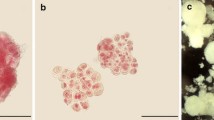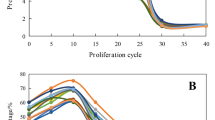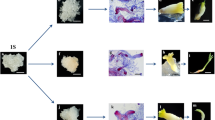Abstract
Cellular redox state and hormone levels have important regulatory roles in the process of somatic embryogenesis (SE), but experimental data on the topic are limited in conifer SE. This study investigated changes in redox pairs (reduced glutathione (GSH) vs oxidized glutathione (GSSG) and ascorbic acid (ASA) vs dehydroascorbate (DHA)), activities of enzymes (glutathione reductase (GR), DHA reductase (DHAR), and ascorbate peroxidase (APX)), and levels of endogenous hormones (indole-3-acetic acid (IAA), zeatin-riboside (ZR), gibberellin (GA), and abscisic acid (ABA)) following exogenous supplements of 2,4-dichlorophenoxyacetic acid (2,4-D), GSH, and L-buthionine sulfoximine (BSO) to the proliferation medium of Picea pungens SE and linked the changes with proliferation efficiencies. While 2,4-D promoted proliferation and maturation in a concentration-dependent manner, the joint application of 2,4-D (2 mg/L) and GSH (0.5 mmol/L) was the most effective. Such beneficial roles were not observed when GSH alone was applied and exogenous BSO (1 mmol/L) prohibited proliferation. Supplements of 2,4-D and GSH, individually or jointly, enhanced the GR activity, decreased the DHAR activity and increased amounts of redox compounds, yet more in GSH and ASA than in GSSG and DHA, creating reduced environments. Exogenous BSO had reversal effects, creating an oxidized environment, and so was the joint use of 2,4-D and BSO, although at a less extent. 2,4-D and GSH reduced while BSO increased IAA content. The alternations in redox state as well as in IAA content from exogenous 2,4-D or BSO supplements coincided with the corresponding changes in proliferation. The notable finding was that exogenous GSH, regardless its substantial roles in reducing environments or IAA content, did not improve proliferation. Thus, the role of GSH on proliferation varied, depending on 2,4-D existing, and could not be fully accounted for by dynamic changes in redox state or hormone level. Alternations in APX and hormones ABA, ZR, GA, and IAA/ABA ratio were also found not highly involved in altering proliferation.







Similar content being viewed by others
Abbreviations
- ABA:
-
Abscisic acid
- AsA-GSH cycle:
-
Ascorbate–glutathione cycle
- APX:
-
Ascorbate peroxidase
- AsA:
-
Ascorbic acid
- BSO:
-
L-buthionine sulfoximine
- 2,4-D:
-
2,4-Dichlorophenoxyacetic acid
- DHA:
-
Dehydroascorbate
- DHAR:
-
Dehydroascorbate reductase
- EC:
-
Embryogenic calli
- GA:
-
Gibberellin
- GR:
-
Glutathione reductase
- GSH:
-
Reduced glutathione
- GSSG:
-
Oxidized glutathione
- IAA:
-
Indole-3-acetic acid
- IAAO:
-
Acetic acid oxidase
- MDHA:
-
Monodehydroascorbic acid
- MDHAR:
-
Monodehydroascorbic acid reductase
- PEM:
-
Proembryogenic mass
- PGR:
-
Plant growth regulator
- SE:
-
Somatic embryogenesis
- ZR:
-
Zeatin-riboside
6. References
Afele JC, Senaratna T, McKersie BD, Saxena PK (1992) Somatic embryogenesis and plant regeneration from zygotic embryo culture in blue spruce (Picea pungens Engelmann). Plant Cell Rep 11:299–303
Arrigoni O (1994) Ascorbate system in plant development. J Bioenerg 26:407–419
Bartoli CG, Casalongué CA, Simontacchi M, Marquez-Garcia B, Foyer CH (2013) Interactions between hormone and redox signalling pathways in the control of growth and cross tolerance to stress. Environ Exp Bot 94:73–88
Belmonte MF, Stasolla C (2007) Applications of dl-buthionine-[S, R]-sulfoximine deplete cellular glutathione and improve white spruce (Picea glauca) somatic embryo development. Plant Cell Rep 26:517–523
Belmonte MF, Yeung E (2004) The effects of reduced and oxidized glutathione on white spruce somatic embryogenesis. In Vitro Cell Dev Biol 40(1):61–66
Belmonte M, Stasolla C, Loukanina N, Yeung EC, Thorpe TA (2003) Glutathione modulation of purine metabolism in cultured white spruce embryogenic tissue. Plant Sci 165:1377–1385
Belmonte MF, Donald G, Reid DM, Yeung EC, Stasolla C (2005) Alterations of the glutathione redox state improve apical meristem structure and somatic embryo quality in white spruce (Picea glauca). Exp Bot 56:2355–2364
Belmonte MF, Ambrose SJ, Ross ARS, Abrams SR (2006) Improved development of microspore-derived embryo cultures of B. napus cv Topas following changes in glutathione metabolism. Physiol Plant 127:690–700
Cao X, Gao F, Qin C et al (2022) Optimizing somatic embryogenesis initiation, maturation and preculturing for cryopreservation in Picea pungens. Forests 13:2097
Earnshaw BA, Johnson MA (1985) The effect of glutathione on development of white carrot suspension cultures. Biochem Biophys Res Comm 133:988–993
Earnshaw BA, Johnson MA (1987) Control of wild carrot somatic embryo development by antioxidants: a probable mode of action of 2,4-dichlorophenoxyacetic acid. Plant Physiol 85:273–276
Filonova LH, Bozhkov PV, von Arnold S (2000) Developmental pathway of somatic embryogenesis in Picea abies as revealed by time-lapse tracking. J Exp Bot 51:249–264
Gao F, Shi Y, Wang R et al (2022) Exogenous glutathione promotes the proliferation of Pinus koraiensis embryonic cells and the synthesis of glutathione and ascorbic acid. Plants 11:2586
Hazubska-Przybył T, Ratajczak E, Obarska A, Pers-Kamczyc E (2020) Different roles of auxins in somatic embryogenesis efficiency in two Picea species. Int J Mol Sci 21:3394
Klimaszewska K, Park YS, Overton C, MacEacheron I, Bonga JM (2001) Optimized somatic embryogenesis in Pinus strobus L. In Vitro Cell Dev Biol Plant 37:392–399
Klimaszewska K, Hargreaves C, Lelu-Walter MA, Trontin JF (2016) Advances in conifer somatic embryogenesis since year 2000. In: Germana MA, Lambardi M (eds) ) In Vitro Embryogenesis in Higher Plants. Humana Press, New York NY
Kong L, Attree SM, Fowke LC (1997) Changes of endogenous hormone levels in developing seeds, zygotic embryos and megagametophytes in Picea glauca. Physiol Plant 101:23–30
Kudełko K, Gaj MD (2019) Glutathione (GSH) induces embryogenic response in in vitro cultured explants of Arabidopsis thaliana via auxin-related mechanism. Plant Growth Regul 89:25–36
Ludwig-Muller J (2011) Auxin conjugates: their role for plant development and in the evolution of land plants. J Exp Bot 62:1757–1773
Park YS, Pond SE, Bonga JM (1993) Initiation of somatic embryogenesis in white spruce (Picea glauca): genetic control, culture treatment effects, and implications for tree breeding. Theor Appl Genet 86:427–436
Pasternak TP, Tvs K, Domoki M, Fehér A (2007) Linked activation of cell division and oxidative stress defense in alfalfa leaf protoplast-derived cells is dependent on exogenous auxin. Plant Growth Regul 51:109–117
Pavei AF, Fraga H, Vieira LN, Guerra MP (2018) Effects of glutathione supplementation and carbon source during somatic embryogenesis of Acca sellowiana (O.Berg) Burret (Myrtaceae). Acta Sci Biol Sci 40:40257
Pullman GS, Zeng X, Copeland-Kamp B et al (2015) Conifer somatic embryogenesis: improvements by supplementation of medium with oxidation–reduction agents. Tree Physiol 35:209–224
Romanov GA, Thomas Schmülling T (2022) On the biological activity of cytokinin free bases and their ribosides. Planta 255:27
Stasolla C (2010) Glutathione redox regulation of in vitro embryogenesis. Plant Physiol Biochem 48:319–327
Stasolla C, Thorpe TA (2004) Purine and pyrimidine nucleotide synthesis and degradation during in vitro morphogenesis of white spruce (Picea glauca). Front Biosci 9:1506–1519
Stasolla C, Yeung EC (1999) Ascorbic acid improves conversion of white spruce somatic embryos in vitro cellular & developmental biology. Plant 36:316–319
Stasolla C, Yeung EC (2003) Recent advances on embryogenesis in culture of coniferous species: irnproving somatic embryo quality. Plant Cell Tiss Org Cvlt 74:15–35
Stasolla C, Belmonte MF, Tahir M et al (2008) Buthionine sulfoximine (BSO)-mediated improvement in in vitro cultured embryo quality is associated with major changes in transcripts involved with ascorbate metabolism, meristem development and embryo maturation. Planta 228:255–272
Tao J, Chen SG, Qin CY et al (2021) Somatic embryogenesis in mature zygotic embryos of Picea pungens. Sci Rep 11:19072
Vieira Ldo N, Santa-Catarina C, de Freitas Fraga HP et al (2012) Glutathione improves early somatic embryogenesis in Araucaria angustifolia (Bert) O. Kuntze by alteration in nitric oxide emission. Plant Sci 195:80–87
Vondrakova Z, Dobrev PI, Pesek B et al (2018) Profiles of endogenous phytohormones over the course of Norway spruce somatic embryogenesis. Front Plant Sci 9:1283
Yeung EC, Belmonte MF, Tu LTT, Stasolla C (2005) Glutathione modulation of in vitro development. In Vitro Cell Dev Biol -Plant 41:584–590
Yu Y, Qin WQ, Li Y et al (2019) Red light promotes cotton embryogenic callus formation by influencing endogenous hormones, polyamines and antioxidative enzyme activities. Plant Growth Regul 87:187–199
Funding
This research is supported by the Major Science and Technology Project “Research on Collection and Preservation Technologies of Germplasm Resources in the Trees of Changbai Mountain” funded by Jilin Provincial Forestry Bureau (2015–002) and the Forestry Science and Technology Promotion and Demonstration Project, “Promotion of Efficient Propagation Technologies in Blue Spruce” funded by the Central Finance of China (No. JLT2021-10).
Author information
Authors and Affiliations
Contributions
Conception, F.G., F.F.Y. and S.Q.C; Writing-draft preparation, F.G., J.T., F.F.Y. and Y.H.W.; Writing-review and editing, F.G., S.G.C., J.T. and Y.H.W.; Experimental planning, F.G, J.T. and S.G.C.; Experiment set up and data collection, Fa.G., F.F.Y., C.Y.Q., J.F.C., C.B.S., C.H.W.; Data analysis, F.G., Y.H.W. All authors have read and agreed to the published version of the manuscript.
Corresponding authors
Ethics declarations
Conflict of interest
The authors declare no conflict of interest.
Additional information
Handling Editor: Peter Hedden.
Publisher's Note
Springer Nature remains neutral with regard to jurisdictional claims in published maps and institutional affiliations.
Rights and permissions
Springer Nature or its licensor (e.g. a society or other partner) holds exclusive rights to this article under a publishing agreement with the author(s) or other rightsholder(s); author self-archiving of the accepted manuscript version of this article is solely governed by the terms of such publishing agreement and applicable law.
About this article
Cite this article
Gao, F., Yan, F., Qin, C. et al. Effects of Exogenous 2,4-Dichlorophenoxyacetic Acid, Glutathione, and L-Buthionine Sulfoximine on Intracellular Redox State and Hormone Levels and Their Links with Proliferation in Picea pungens Somatic Embryogenesis. J Plant Growth Regul (2023). https://doi.org/10.1007/s00344-023-11198-3
Received:
Accepted:
Published:
DOI: https://doi.org/10.1007/s00344-023-11198-3




